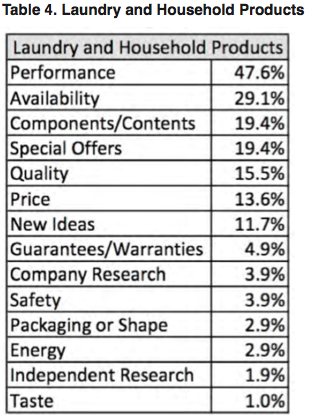From Elon Journal of Undergraduate Research in Communications VOL. 4 NO. 2Appealing to Women: An Analysis of Print Advertisements in Three Women's Interest MagazinesV. ConclusionLiterature review clearly shows that women respond more positively to emotional advertising and remember emotional advertisements more frequently. Women respond to advertisements that are externally focused and involve groups of people.
This study found that the most advertised product categories in women's interest magazines are food and drink, personal care, laundry and household products, medicine,nd clothing and accessories. There was no strong difference between this study and the study performed using the same categories in 1983 in terms of frequency of products advertised. The only large difference was more advertisementsor personal care products in 2013 than 30 years ago. There were some variations among the three magazines in 2013. All these differences resulted from the characteristics of theublications' audience and their core editorial content. When the product categories from the Resnik-Stern Content Classification System were broken down into Taylor's Six-Segment Strategy Wheel, the products in the category of segment 4, the routine segment, made up a whopping 68% of all of the advertisements analyzed. Overall, the information cues used most frequentlyere performance, availability, components/contents, special offers, and new ideas. There was no strong difference in the frequency of cues used between the two studies. The large increase occurred in the cues of availability, new ideas, nutrition, or taste. The most frequently used product categories for personal care were performance, components/contents, and company research. Analysis of food and drink showed that nutrition, components/contents, and taste were the cues used most frequently in that product category. Lastly, it was found that performance, availability, and components/contents were the cues used most frequently in advertisements for laundry and household products.Future research may address the limitations of this study. This study used only every other issue of magazines over a 7-month period. Given more time, all issues could have been coded. Additionally, a future study could expand the number of magazines used. Originally, Ladies' Home Journal was to be used in this study but the amount of advertisements was too large for one coder to handle. Additionally, multiple coders could increase the validity of the data collected. Future research could take into consideration advertisements in iPad and Kindle versions of the publications chosen. AcknowledgmentsThe author would like to extend a great thank you to Professor Byung Lee at Elon University for his guidance, advice and patience, without which the article could not be published. The author also appreciates numerous Elon University faculty members who have helped guide and revise this article. Lastly, the author thanks Elon University for its continued commitment to undergraduate research and engaged learning, which made this research possible. References11 facts about magazines. (n.d.). Retrieved February 20, 2013, from Magazines The Power of Print website:ttp://powerofmagazines.com/get-the-facts.html Abernethy, A. M., & Franke, G. R. (1996). The information content of advertising: a meta analysis. Journal of Advertising, 25(2), 1-17. Al-Olayan, F. (n.d). A content analysis of magazine advertisements from the United States and the Arab world. Journal of Advertising, 29(3), 69-82. Ambler, T. & Burne, T. (1999) The impact of affect on memory of advertising, Journal of Advertising Research, 39(2), pp. 25-34. Baird, T. R., Wahlers, R. G., & Cooper, C. K. (2007). Non-recognition of print advertising: emotion arousal and gender effects. Journal of Marketing Communications, 13(1), 39-57. doi:10.1080/13527260600942616 Brizendine, L. (2007) The female brain. London: Bantam. Brunel, F. & Nelson, M. (2003) Message order effects and gender differences in advertising persuasion. Journal of Advertising Research, 43(3), pp. 330-341. Canli, T., Desmond, J.E., Zhao, Z., and Gabrieli, J.D.E. (2002) Sex differences in the neural basis of emotional memories. Proceedings of the National Academy of Sciences of the United States of America 99: 10789-10794. Cramphorn, M. F. (2011). Gender effects in advertising. International Journal of Market Research, 53(2), 147-170. doi:10.2501/IJMR-53-2-147-170 Harmon, R. R., Razzouk, N. Y., & Stern, B. L. (1983). The information content of comparative magazine advertisements. Journal of Advertising, 12(4), 10-19. The Hearst Corporation (2013) O, The Oprah Magazine [Media Kit] Retrieved from http://www.omediakit.com/5/home.asp James, William M. (2011) The appeals of luxury advertising: an application of Taylor's six segment message strategy wheel. The Elon Journal of Undergraduate Research in Communications, 2(2), pp. 62-75. Linly, C., Franke, G. R., & Wilcox, G. B. (1987). The information content of comparative magazine ads: a longitudinal analysis. Journalism Quarterly, 64(1), 119-250. Martha Stewart Omnimedia (2013) Martha Stewart Living Media Kit [Media Kit] Retrieved from http://mslomediakit.com Morris, P. K., & Nichols, K. (2013). Conceptualizing beauty: a content analysis of U.S. and French women's fashion magazine advertisements. Online Journal of Communication & Media Technologies, 3(1), 49-74. Real Simple (2013) Real Simple Media Kit [Media Kit] Retrieved from http://www.realsimple.com/static/rsr/rint-media-kit/ Seitz, V. A., & Razzouk, N. (2005). Romanian print advertising: a content analysis. Journal of Promotion Management, 12(1), 3-16. doi:10.1300/J057v12n01-02 St. James, Melissa. (2010). Female celebrities targeting female teenagers: a content analysis of magazine advertising. Journal of Business & Economics Research, 8(1), 1-13. Taylor, R. R. (1999). A six-segment message strategy wheel. Journal of Advertising Research, 39(6), 7-17. U.S. women control the purse strings. (2013, April). Retrieved from Nielsen website: http://www.nielsen.com/s/en/newswire/2013/u-s--women-control-the-purse-strings.html Weiner, M. (Writer), & Taylor, A. (Director). (2007, July 19). Smoke gets in your eyes [Television episode]. In S. Hornbacher, A. Jacquemetton, M. Jacquemetton, J. Leahy, & M. Weiner (Producer), Mad Men. New York, NY: AMC. Suggested Reading from Inquiries Journal
Inquiries Journal provides undergraduate and graduate students around the world a platform for the wide dissemination of academic work over a range of core disciplines. Representing the work of students from hundreds of institutions around the globe, Inquiries Journal's large database of academic articles is completely free. Learn more | Blog | Submit Latest in Business & Communications |




















